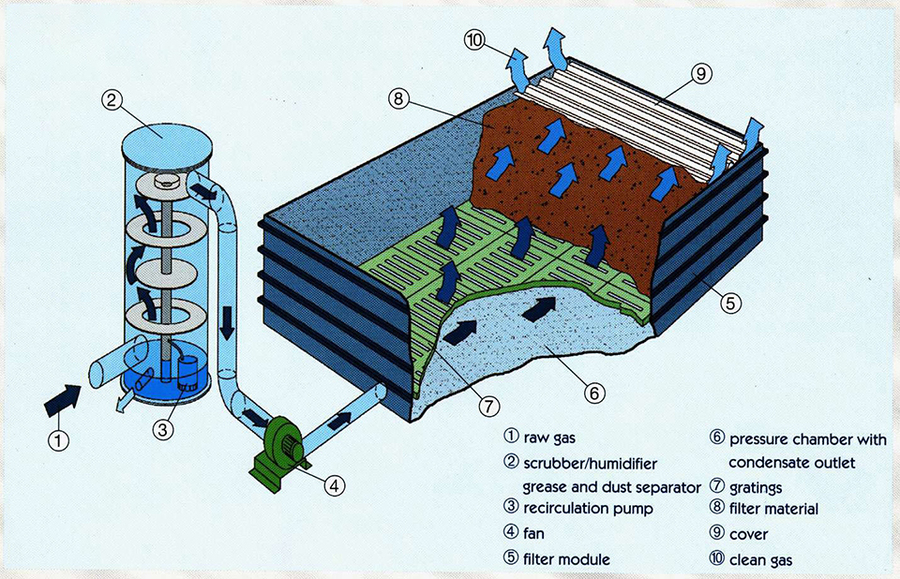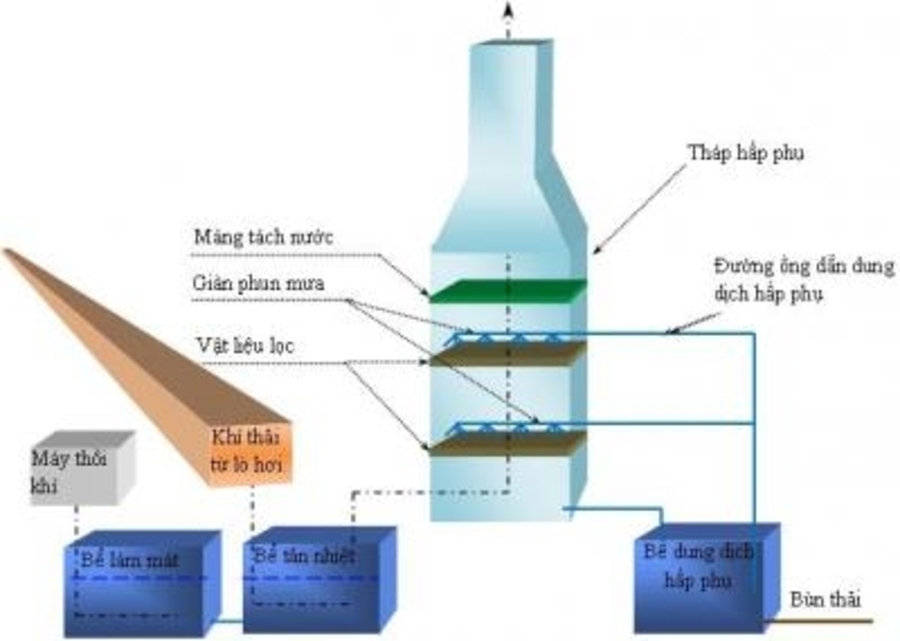Air pollution control is one of the most important issues in today's industrial and manufacturing sectors, especially as environmental pollution continues to intensify. Implementing effective air pollution control methods not only helps minimize negative environmental impacts but also complies with legal requirements for environmental protection. Let’s explore the various air pollution control methods with Đại Nam to help your business choose the most optimal solution for environmental protection.
1. Chemical Absorption Method for Air Pollution Control
.jpg)
The chemical absorption system in factories uses chemical solutions to remove hazardous exhaust gases
1.1. Principle
The chemical absorption method involves passing exhaust gases through a chemical solution capable of reacting with harmful components in the air to eliminate them. These pollutants are typically acidic compounds, strong oxidizing agents, or foul-smelling gases. The chemical solution reacts with the exhaust gases, transforming them into non-harmful forms or ones that are easily removed.
1.2. Applications
This method is widely used in industries like chemical production, pharmaceuticals, food processing, and seafood processing, particularly for treating exhaust gases with high acidity such as SO₂, HCl, CO₂, and others.
1.3. Advantages and Disadvantages
Advantages:
-
High efficiency, capable of treating a variety of exhaust gases.
-
Can remove gases at low concentrations.
-
Energy-efficient and easy to control.
Disadvantages:
-
Requires regular replacement or treatment of the absorption solution.
-
The chemical process may generate by-products that require additional treatment.
2. Physical Absorption Method for Air Pollution Control
2.1. Principle
Physical absorption involves using absorbent materials such as activated carbon, zeolite, or other porous substances to capture and retain harmful gas molecules from exhaust streams. This process does not involve a chemical reaction but is based on the physical interaction between the gases and the absorbent material.
2.2. Applications
The physical absorption method is mainly used in industries where the exhaust gases contain volatile substances such as VOCs (Volatile Organic Compounds), foul-smelling gases, or gases that do not easily react with chemicals.
2.3. Advantages and Disadvantages
Advantages:
-
Simple process, no harmful chemicals required.
-
Effective for treating volatile gases.
-
Easy to operate and maintain.
Disadvantages:
-
Not effective for high-concentration gases or hazardous gases that are difficult to absorb.
-
Absorbent materials need to be regenerated or replaced periodically.
-
Requires large installation space for activated carbon systems.
3. Thermal Incineration Method for Air Pollution Control
3.1. Principle
Thermal incineration is a method that uses high temperatures to oxidize harmful components in exhaust gases into non-harmful products, mainly CO₂ and H₂O. This method is typically used to treat exhaust gases containing flammable organic compounds or gases that cannot be effectively absorbed by other methods.
3.2. Applications
Thermal incineration is widely used in industries like paint manufacturing, chemical production, petroleum, and other sectors where exhaust gases contain easily flammable organic compounds. It is ideal for eliminating high-concentration gases of difficult-to-treat compounds.
3.3. Advantages and Disadvantages
Advantages:
-
Effectively treats exhaust gases containing organic compounds and hazardous gases.
-
Reduces harmful emissions and avoids secondary pollution.
-
Quick and easy treatment process.
Disadvantages:
-
Requires very high temperatures, increasing energy costs.
-
The process can generate NOx and other pollutants if not carefully controlled.
-
Requires specialized equipment and regular maintenance.
4. Biological Filtration Method for Air Pollution Control

Biofiltration system uses microorganisms to decompose organic exhaust gases
4.1. Principle
Biological filtration uses microorganisms to decompose organic pollutants in exhaust gases. These microorganisms digest organic compounds in the exhaust and convert them into harmless substances such as CO₂ and H₂O. This method is environmentally friendly and effective for treating gases with biodegradable organic compounds.
4.2. Applications
Biological filtration is widely used in industries such as food processing, pharmaceuticals, and other sectors that produce exhaust gases containing biodegradable organic compounds. This method is environmentally friendly and applied when treating gases that are non-toxic or low in toxicity.
4.3. Advantages and Disadvantages
Advantages:
-
Environmentally friendly, no secondary waste production.
-
Low operating costs and easy maintenance.
-
Natural process, no need for chemicals or additional energy.
Disadvantages:
-
Effective only for biodegradable organic compounds.
-
Requires stable environmental conditions for optimal microbial activity.
-
The treatment time may be longer compared to other methods.
5. Adsorption Method for Air Pollution Control

Exhaust gas system uses activated carbon to remove air pollutants
5.1. Principle
Adsorption is a process where exhaust gases are treated using absorbent materials like activated carbon or zeolite to capture harmful molecules from the air. This process occurs through physical interaction between gas molecules and the surface of the absorbent material.
5.2. Applications
The adsorption method is used in industries where exhaust gases contain substances that are easily adsorbed, such as organic compounds and foul-smelling gases.
5.3. Advantages and Disadvantages
Advantages:
-
Simple and effective for treating many types of exhaust gases.
-
Easy to install and operate.
-
Low maintenance costs.
Disadvantages:
-
Absorbent materials need to be replaced after use.
-
Requires close control to prevent overloading the absorbent materials.
Air pollution control is an essential part of industrial operations to protect the environment and public health. To choose the most suitable air pollution control method, businesses need to consider factors like the type of exhaust gases, investment costs, and environmental protection requirements. Đại Nam is a reputable provider of air pollution control solutions, helping your business not only meet legal requirements but also contribute to sustainable environmental protection. Contact Đại Nam for expert advice and effective air pollution control system implementation for your business.
.jpg)

